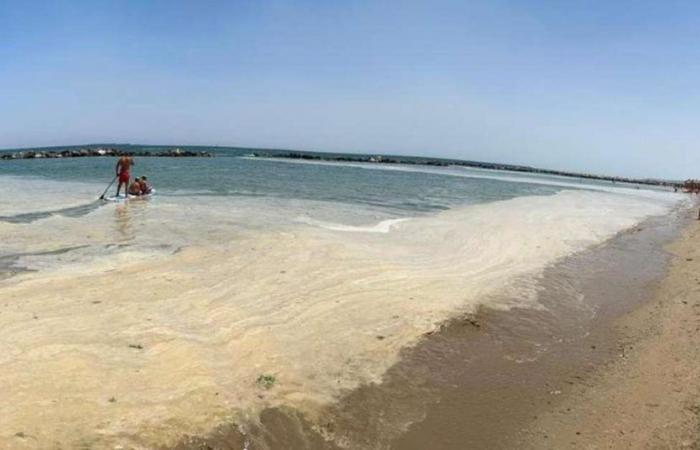PESCARA. The weekend with the African heat, and the beaches assaulted by bathers, spoiled by the invasion of mucilage. The layer of color between yellowish and brown also covered yesterday, as has been happening for several days, the water in the stretch of sea in the city and in that of Francavilla. If on Friday and Saturday the cases had been reported everywhere on the Pescara and regional coast, yesterday the most evident episodes occurred on the stretch south of the river.
Since the early hours of the morning, given the high temperatures, the beach of Pescara was crowded with families and, in general, with bathers looking for refreshment in the water. If at the beginning of the day the situation was not the best, but bearable, as the hours passed the scenario changed significantly. For the worse. By lunchtime it was almost impossible to swim, so vast and unpleasant was the “expanse” of mucilage in the water. Thus, thousands of people remained under palm trees and umbrellas, or in the establishments, to seek relief in the shade. But there were also those who preferred to go home.
A mockery for the managers of the city beaches, who try to attract families and tourists, and who are already forced to deal with the high cost of living and the thousand difficulties of customers, but also natural phenomena like this. The slime is in fact caused by the high temperatures of these days and by the floods that previously hit northern Italy, with large spills into the sea from the main rivers. And, in the last few hours, also by the absence of currents that can remove the stagnant substances in the sea. To see the crystalline waters of the past weeks again, experts say that we will have to wait for the next incoming disturbance (storms are expected tomorrow).
Despite the unpleasant sensation – both visual and upon contact with water – the presence of mucilage in the sea does not cause concern for the health of bathers.
These are aggregates of polysaccharides (complex sugars), which appear in the form of strips or networks, of small and large dimensions, of organic magma. Over the past weekend it has been observed both in suspension and on the bottom in almost all stretches of the Abruzzo coast. The sighting began last Thursday, about 3 miles from the coast.
Off the coast of Francavilla, yesterday and Saturday, a strip of mucilage was observed within 300 meters of the coastline, about 5 meters wide and tens of meters long, accumulated along the current front. The algae are present on almost the entire coast, but Arta recalls that “there is no danger for humans, apart from the annoying sensation and, in rare cases, the itching that contact with the “macroflakes” of mucilage can cause. In recent days the phenomenon, originating from Veneto, had been observed along the coasts of the Marche. The conditions of abundant rainfall in this last period, which have enriched the sea with nutrients through river contributions, have probably favored, together with the high temperatures, the proliferation of blooms of phytoplankton species that can secrete mucous-type substances as a completely natural physiological process”. Arta will continue to monitor the situation and, if the phenomenon were to intensify, will carry out additional sampling, with analytical investigations, which will concern, in addition to the normal biological parameters, also the determination of chemical parameters, nutrients and phytoplankton.
For Latest Updates Follow us on Google News






